
2023 Railroader of the Year: Katie Farmer, BNSF
Written by William C. Vantuono, Editor-in-Chief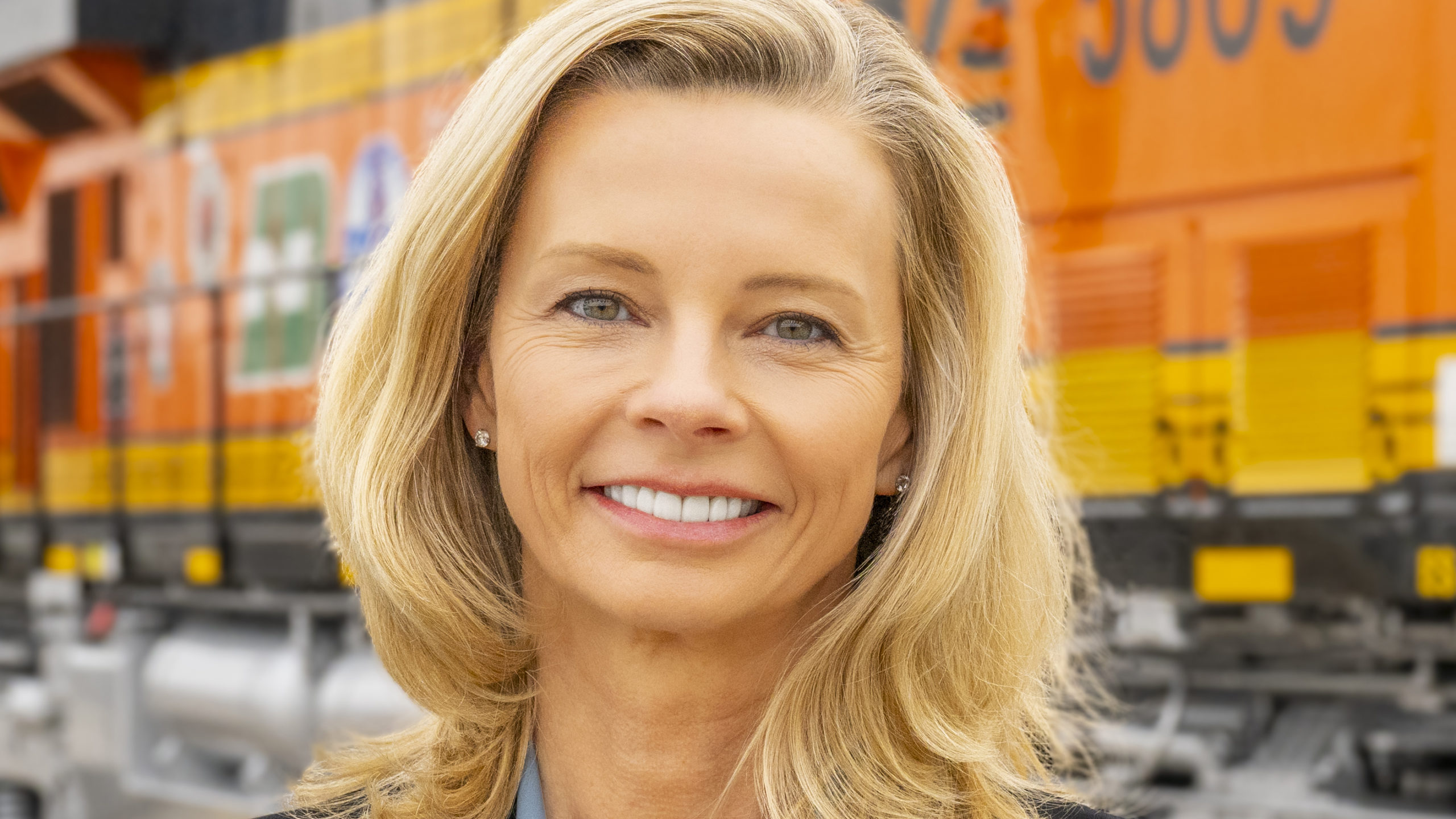
BNSF President and Chief Executive Officer Katie M. Farmer (BNSF Photograph)
RAILWAY AGE, JANUARY 2023 ISSUE: Railway Age’s 2023 Railroader of the Year Award, the 60th annual, goes to a groundbreaking North American rail industry leader: BNSF President and Chief Executive Officer Katie M. Farmer.
Katie Farmer permanently changed the industry for the better by becoming the first female chief executive of a Class I railroad. She took the throttle of North America’s largest railroad, in terms of both route-miles and revenue, during unprecedented times, in the midst of a global pandemic. She has continued to press forward during a challenging, post-pandemic period, dealing with global supply chain and service problems, as well as a difficult labor market, focusing on building a better BNSF.
Katie knows her railroad inside and out. She’s held leadership positions in every major function of the company, overseeing a 32,500-route-mile network that spans 28 states and touches three Canadian provinces. She has been working with her team to shape the legacy of BNSF, which has seen industry-leading growth. In late 2020, when she was named as the railroad’s next chief executive, she told Railway Age how proud she was of the men and women of BNSF—railroaders who ‘know how to do hard’—and looked forward to continuing BNSF’s success.
Katie was appointed BNSF President and CEO in January 2021. She has been with BNSF for more than 30 years, previously serving as Executive Vice President Operations since September 2018, where she oversaw the entire Operations organization. Farmer received a bachelor’s and master’s degree from Texas Christian University. Upon graduation, she began her career with BNSF predecessor Burlington Northern in 1992 as a management trainee in Fort Worth, Tex., following an internship in the Engineering department between her junior and senior years in college.
Katie Farmer is the ninth person from BNSF or one of its predecessor railroads named Railroader of the Year in the award’s six-decade history: Louis W. Menk, Northern Pacific (1967); John S. Reed, Atchison, Topeka & Santa Fe (1970); Lawrence Cena, AT&SF (1981); Darius W. Gaskins, Jr., Burlington Northern (1988); Robert D. Krebs, AT&SF, and Gerald Grinstein, BN (1996); Matthew K. Rose, BNSF (2010); and her immediate predecessor, Carl R. Ice, BNSF (2016).
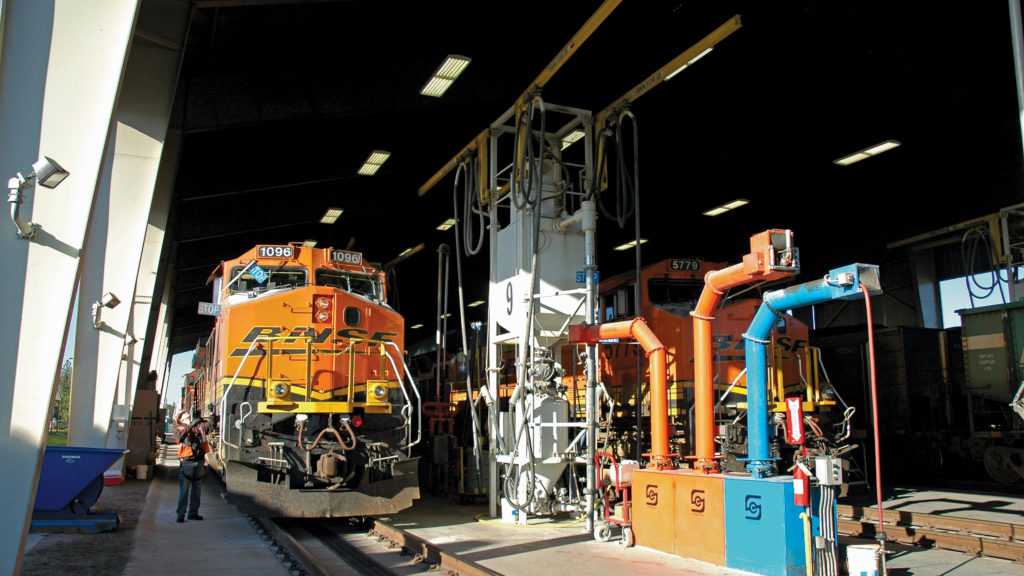
RAILWAY AGE: Congratulations on being named Railroader of the Year. You are the first female CEO of a Class I railroad. This award goes back 60 years, and you are the first woman to be named Railroader of the Year.
KATIE FARMER: Thank you, Bill. It’s an honor to be included with leaders who have had an impact on the industry, including my predecessors. But I really do think it’s important to acknowledge that BNSF is not great because of one person’s work, but because of all our 35,000 employees. They’re due the credit for BNSF’s success.
RAILWAY AGE: You joined Burlington Northern right out of college as a management trainee. How did you find your way to railroading and what was it about BN that attracted you? Did you ever imagine yourself as a long-term railroad employee?
KATIE FARMER: I was drawn to Burlington Northern because of the importance of what we do. Really, the relevance of railroading and freight railroads that are the backbone of the U.S. economy. They move everything from energy to heat our homes to the clothes that we wear. If you look at the importance of what we do just at BNSF alone, we move, for example, a quarter of the grain and grain products in this country. We saw this again with great clarity during the pandemic. We moved a lot of PPE and medical supplies that the nation needed. I’m really proud of that. At BNSF, we take a lot of pride in knowing that we’re helping so many companies across this country, and helping to strengthen the competitiveness of the United States.
If I could go back and ask my 20-year-old self, did I plan on being a long-term railroader? I’m not sure of the answer to that. But what I am sure of is that railroading is a high calling. And what we do matters. The relevance and the importance is a key reason why people, I think, make a career of railroading, much like myself.
RAILWAY AGE: These days when there are so many career choices, so many career paths, and younger people don’t tend to stay in one place for a very long time, why should a young person come to work for a railroad? What’s the attraction? What’s the incentive?
KATIE FARMER: I believe doing something that matters appeals to people of all ages, to know that what you are doing is a part of something larger than yourself that contributes to society. One of the things I say to young people as they’re looking at this industry is, the U.S. economy doesn’t function without rail and what it provides for the supply chain. To be a part of that every day, to know that what we’re doing and working on together really makes a difference. If you look back at our company, we’re a combination of predecessor railroads over the past 170 years—what we do is as relevant today as it was 170 years ago.
We’ve accomplished that because we’ve innovated, we’ve evolved, we’ve stayed relevant. The one thing that’s never changed over all those 170 years is the difference we make and the relevancy of the rail industry. I would add that the other thing I think really appeals to young people starting out their career is the breadth and diversity of experiences you can have at a railroad. A lot of people don’t realize that. I think we need to do a better job telling our story about all the different careers you can have just within the rail industry, whether it’s finance, marketing, operations, engineering—you name it.
One of our challenges is communicating that relevancy and the importance of the rail industry to young people, because it’s not natural, per se, for people to think about it. We’re kind of unsung heroes. Although the past several years we’ve been at the forefront, we’re not typically something that young people might naturally think of gravitating toward. For young people coming out of school thinking about what they want to do, it’s very different than when I was coming out of school. I was looking at, frankly, how do I pay my bills? This generation really thinks about how they can make a difference, waking up every day doing something that motivates and excites them. That’s a bit of a shift. If we tell our story correctly, there aren’t many companies that you can say have been around for 170 years and make such a big difference in this country and the world. That’s why I’ve stayed in this career for 30 years. I get excited every harvest, every UPS peak season. Those are tangible things where you can see how we make a difference.
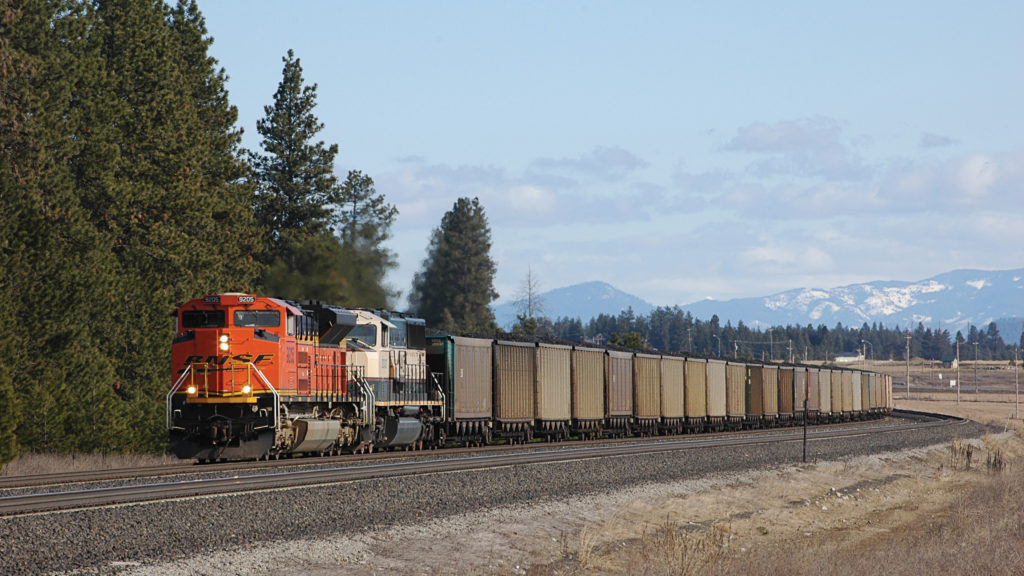
RAILWAY AGE: When you were named to succeed Carl Ice as CEO of North America’s biggest Class I, and as the first woman ever in that position, how was that experience for you personally?
KATIE FARMER: Carl, and Matt Rose before him, really did an incredible job positioning BNSF to be successful well into the future. Who I am as a leader has been shaped by our culture. I’ve been a part of this company’s leadership team for more than a decade and have helped shape our direction. From day one, I’ve said my focus as a CEO is to continue to lead BNSF on a journey to fulfill our vision by really positioning us to succeed during all business cycles. At any given time or in any given year, we see fluctuations in our business, decreases or increases in our volume across all the various markets we serve.
To be successful, we know that we must always stay focused on growth. One thing truly consistent about BNSF is our focus on growth. We need a bias for growth to be successful in growing with our customers. We really have to be nimble and agile enough to reinvest in our business and have capacity so we can say “yes” to our customers. We’re in business for our customers. That was the focus in our past when we became a combined company, and it’ll be the focus of who we are going forward. One thing I have learned is that it’s critically important we continue talking about that journey every day. It remains a part of our culture. It’s just who BNSF is, and it’s who we will be as we move into the future.
RAILWAY AGE: You’ve been with BNSF for 30-plus years, and you’ve had numerous roles in your career. What are the accomplishments you’re most proud of, those you believe have had the most impact for your company?
KATIE FARMER: Even though I’ve been here 30 years, I certainly hope our greatest accomplishments are yet to come. One area I am really focused on is ensuring that others have access to the same opportunities to develop that I’ve been given over my career. Our culture at BNSF is to identify potential and really help individuals to grow and develop to their full potential. We talk about our people as our differentiator. We hire the best, we keep them engaged, we empower them to do what’s right and we invest in their professional development. I look forward to continuing to ensure that those opportunities continue to exist for future generations.
I would also say there are a couple of recent accomplishments of which I’m particularly proud of our team—last year’s agreement with J.B. Hunt, our largest service provider and our partner. It’s a big leap forward for our intermodal product, a commitment to bring additional capacity to the marketplace while continuing to evolve our joint service product. It’s going to ensure that customers have a more seamless experience in the future with BNSF and J.B. Hunt’s intermodal product. And it’s going to be a big differentiator for us in the marketplace and facilitate our continued growth for years to come.
Also, while it’s not yet complete and yet to be approved by the Surface Transportation Board, bringing back Montana Rail Link into the BNSF network is something that all of us at BNSF will be proud of. Having been a former Burlington Northern employee myself, what it means to the history of BNSF and our predecessor railroads means a lot to our people. And we now have a shared legacy with the great employees of the MRL. To honor their efforts, and provided the STB approves the lease termination, the MRL will become the MRL Subdivision of our Montana Division. It’s really a fitting tribute to the history of both these great railroads.
RAILWAY AGE: Operationally and growth-wise, that seems to be a very good strategic move on BNSF’s part.
KATIE FARMER: Absolutely. We are excited for the opportunities that it presents for our customers to have a more seamless product. And we have added a second main line on our new Lake Pend Oreille Bridge at Sandpoint, Idaho. This opens up capacity and will allow us to continue to offer more consistent service for our customers, both along the Northern Transcon and our Central Corridor, as well. It’s an incredible project, the work that [BNSF Vice President Engineering] John Cech and his team have done and many others is remarkable. It has been a multi-year cross-functional effort with lots of support from lots of folks, and it’s going to be great for our customers.
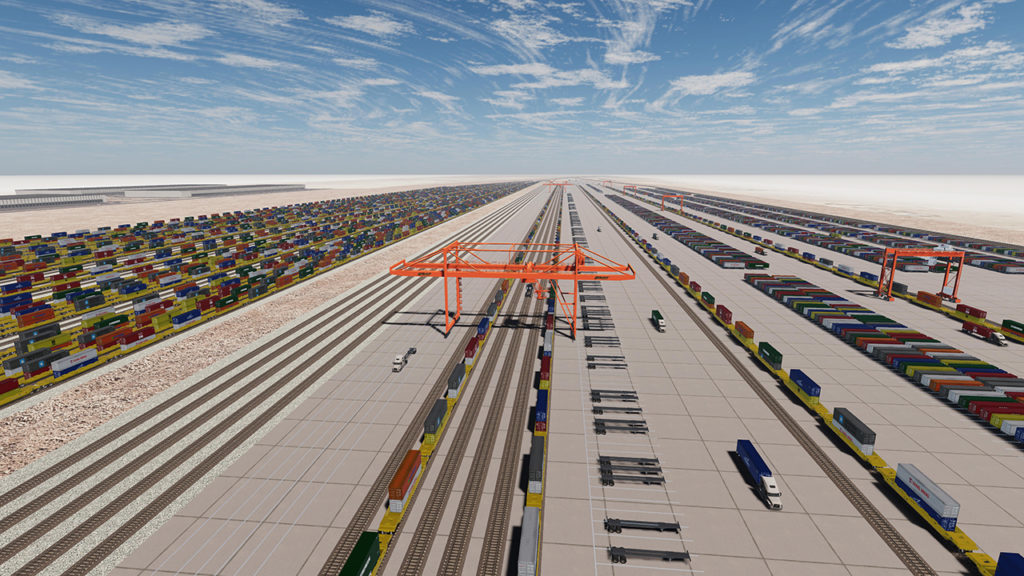
RAILWAY AGE: Also, Barstow International Gateway.
KATIE FARMER: Barstow International Gateway is going to be the largest intermodal facility in North America when fully built out. It will sit on more than 4,500 acres. It is going to be a state-of-the art integrated rail facility in Southern California consisting of a rail yard, an intermodal facility, and warehouses for transloading freight from international to domestic containers. The facility will allow direct transfer from containers through the ports of Long Beach and Los Angeles, through the Alameda Corridor and onto BNSF’s main line up to Barstow. Once the containers reach Barstow, they’ll be processed at the facility. We’ll use clean energy-powered cargo handling equipment, and then we’ll build and stage trains moving east via our Southern Transcon.
We’re excited about this. We think it really will help maximize rail and distribution efficiency across the entire U.S. supply chain. It will reduce truck traffic and freeway congestion. It’ll have a critical role in the competitiveness of the West Coast, improving the fluidity of our network. The people of Barstow have been great supporters of it. It’s another example of our bias for growth, a clear example of investment in capacity that will help us continue to reinvent ourselves, adapt and offer a more seamless product for our customers.
RAILWAY AGE: So, it’s a “BIG” part of your growth strategy? That’s a great name.
KATIE FARMER: Well said! We’re still testing the name, so we’ll see if it sticks.
RAILWAY AGE: The past few years have been difficult for the industry. The past year has been especially challenging. The rail industry in general now has a lot of work to do in mending relationships with employees and regaining customer confidence. What are the next steps? What will be your approach? What do you think the industry in general has to do differently going forward?
KATIE FARMER: We’ve all faced challenges during the past few years as we have navigated our way through the pandemic, the great resignation, supply chain challenges, and certainly the most recent bargaining round. Let me start with our people. As I said earlier, our people are our differentiator. BNSF is great because of the hard work and commitment day in and day out of our 35,000 people who deliver on our promise to our customers. None of what we accomplish happens without them. We recognize that railroading is tough, essential work that BNSF team members do safely every day. And we have always supported and provided fair compensation and benefits for our employees. While the new agreement has the highest wage increases in decades and best-in-class healthcare, we recognize there’s more to be done to further address our employees’ work-life balance concerns.
We hear and recognize the deeply felt concerns regarding quality of life. And I fully intend to work collaboratively with our employees and the unions to find the right balance. We have started those discussions. At the end of the day, we want BNSF to be not only a great place to work, but also a great place to have a career for everyone who works here. It has been a challenging couple of years, but we’re a 170-year-old company, and we have seen our share of challenges. Short-term challenges don’t erase what we have, what all of us have built together at BNSF. We’ll continue to work with our people. We’ll continue to work with their unions to create opportunities to enhance rail careers, to promote safety, to support environmentally friendly and efficient transportation. We’re going to continue to do the things we need to do to strengthen the backbone of the U.S. economy. So, we’ll continue those discussions and evolve as we always have over the years.
Turning to the supply chain, we often say railroading is a momentum business. This applies more broadly to the whole supply chain. When one part of the supply chain struggles, we all struggle. When volume fluctuates, we adapt to that variability, and that’s not new for us. The difference is the pandemic impacted the entire global supply chain, which, as you know, is a complex system of connections among ports, railroads, trucks and our customers.
As we were moving through the pandemic and we saw consumers shift from services to goods, more freight went into the supply chain. And unfortunately, labor left the workforce, and it did create a series of disruptions. It created a series of shortages—chassis drivers, labor to support distribution center unloading. All of this slowed overall velocity. That caused shipments to back up in rail facilities and at the ports. We take a lot of pride at BNSF in delivering customers safe, efficient, consistent and reliable service. And we faced some challenges this past year. However, I would tell you that we have made significant progress. Service is close to pre-pandemic levels. We have strong momentum in restoring the service customers have come to expect and that we, frankly, expect from ourselves.
There are, however, some good things that have come out of the supply chain challenges. There is increased collaboration, information sharing and accountability across the supply chain. But there is more to be done. The supply chain continues to evolve. We have to evolve as an industry in order to remain competitive. It’s imperative that we find ways to continue to collaborate and work more closely, not only across the supply chain, but also with our customers.
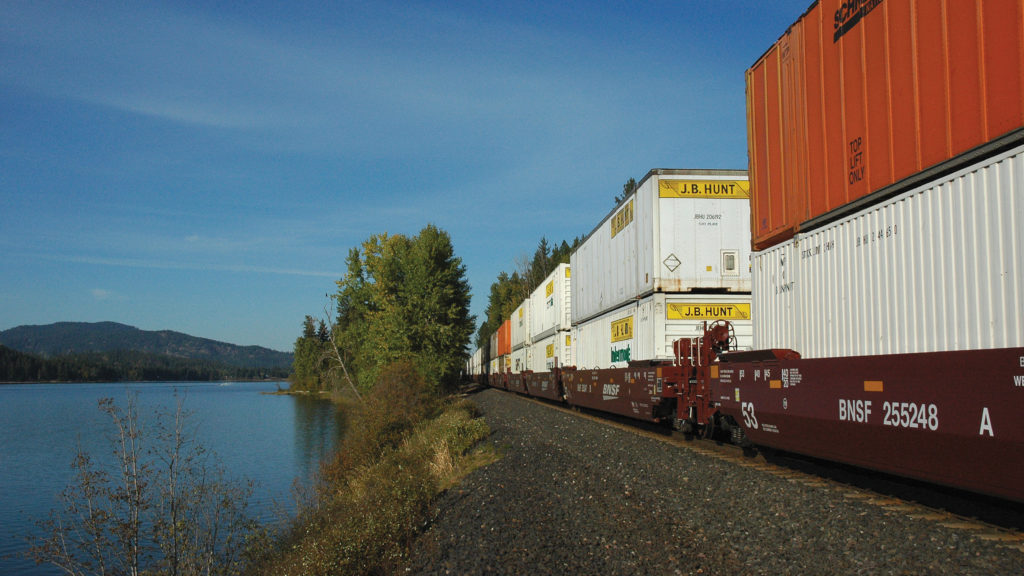
RAILWAY AGE: That’s a good short-term outlook. What is your long-term outlook for the industry? What do BNSF and the industry need to do to be competitive, to be relevant as supply chains evolve? How does BNSF plan to leverage technology?
KATIE FARMER: The rail industry is really focused on implementing new technologies and delivering better and more consistent service. Those are the key drivers. That’s how we increase the value proposition for rail and the supply chain. Driving sustainable and profitable business growth requires the right capabilities, strategy and mindset. As I mentioned earlier, the heart of how we operate is around growth. But we are also keenly aware that to be successful, we must continue to evolve with the supply chain.
When you look at all of our predecessor companies, if BNSF moved the same commodities today and operated in the same way as our predecessors, we’d be out of business. So being agile in the marketplace, being nimble and able to pivot to new opportunities with our customers is how we stay relevant. And we are also continually focused on improving the experience of our customers, both in the transit of their goods and overall making it easier to do business with us. Customers now don’t just require consistent and reliable service. They also want tools, transparency, the ability to track shipments throughout the supply chain.
We need to continue to focus on integrating more deeply into our customers’ supply chains and their processes and making it easier to do business with us—creating value so that BNSF remains the customers’ transportation provider of choice for the long term. So, growth is how we think about the long term. We don’t just focus on growth as an annual objective or for a specific market opportunity. Again, this has been the key to our success over time. We’re committed to having the capacity, equipment and people that allow us to grow with our customers and say “yes” to new business opportunities. That’s really what’s critical to our success.
BIG is just one in a long line of investments toward growth and to better align with our customers. If you look back, we have our Logistics Park strategy, which uses our intermodal hub as a centerpiece to locate distribution centers nearby. That helps our customers to streamline their supply chain, sustainably lowering transportation costs, reducing fuel costs, lowering carbon emissions. This has been our focus for years. We pioneered the Logistics Park concept back in 1993 with our facility in North Fort Worth at Alliance. In 2002, we opened Logistics Park Chicago, and we’ve seen continuous expansion at both of those facilities since their inception. And then in 2013, we opened Logistics Park Kansas City in Edgerton, Kans., to serve the growing Midwest market.
RAILWAY AGE: Years ago, Railway Age ran a cover story titled with a quote from Rob Krebs: “Grow or Die.” Would you call it a mantra?
KATIE FARMER: It’s foundational to who we are at BNSF. It’s in our DNA. We clearly recognize that we are in business to help our customers succeed. And the way we do that is positioning ourselves to be able to say “yes” when they bring us an opportunity and have the capacity and investment to be able to support their opportunities.
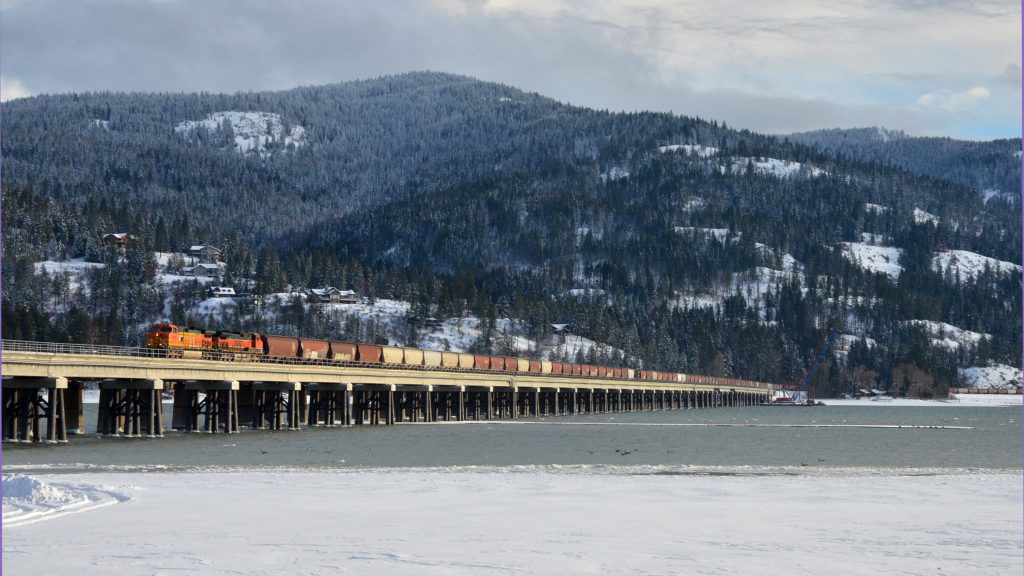
RAILWAY AGE: Over the years, capital investment at BNSF has always been strong. To my knowledge, it has really never let up, even though the economy is cyclical. You need to continue investing in capital to maintain not only a state of good repair, but also to be prepared for growth, to be ready for it, able to handle it.
KATIE FARMER: I agree 100%. We clearly recognize that we have to take care of our infrastructure every year, regardless of what happens in the economy. And then we have to think ahead. To your point, what that means is you have to continue to invest to be in a position to have the capacity when those markets bring you opportunities.
RAILWAY AGE: Let’s talk a bit about technology and sustainability advancements. What is BNSF doing in both spaces?
KATIE FARMER: We employ and create advanced technology to continually improve safety, efficiency, service reliability, consistency and the customer experience. Those are the lenses that we look at when evaluating investment in technology. One of the areas we’re looking at is the pursuit of energy efficiency. It’s one of our top priorities as we look to reduce our environmental impact. More than 90% of our emissions come from our locomotives. We look at locomotive technology to improve our fuel efficiency. We have the largest number of the newest and cleanest locomotives in North America. We have idle reduction systems on most of our line haul locomotive fleet, and we are testing higher blends of biodiesel and renewable diesel. We are partnering in the development of zero-emissions locomotives, and that includes battery-electric, as well as hydrogen to reduce our environmental impact and helps us increase fuel efficiency, as well as lower operational costs—a win for the environment, our customers and the operation. A battery-electric locomotive uses about half of the energy of a diesel locomotive. Ultimately, they’ll be able to do the same work.
We continue to look for opportunities to lead in piloting zero-emissions technologies, whether it be on our locomotives or in our intermodal facilities, with battery-electric yard trucks or electric cranes, which we’re already using. All of these technologies are helping to reduce emissions in the communities in which we operate. We’re continuing to evolve and innovate, and we understand that technology is a big part of our future if we’re going to meet the demands of our customers, our employees and communities, as well as our environmental responsibility.
RAILWAY AGE: There’s a lot going on in the industry in terms of leveraging technologies like artificial intelligence, machine learning. I remember doing stories on reading hot bearings, something BNSF was doing years ago. This seems to have taken an almost exponential leap.
KATIE FARMER: We are employing machine vision and automated track inspection using autonomous geometry cars. Look across the spectrum of our business, and we have exciting things happening with technology. We’ll continue to invest in anything we can do to make our railroad safer, more efficient, and to provide a better product for our customers.
RAILWAY AGE: Employing and investing in state-of-the-art technology should make our old “bricks and mortar” industry attractive to young people. Here’s a big industry that moves goods on tracks with trains. But we employ modern technologies and will continue to advance them, so here’s an opportunity for you, the young person, to develop your skills and contribute to that.
KATIE FARMER: Absolutely. That goes back to continuing to tell our story and communicating with people looking to make a career in the rail industry. The idea that you can come to a 170-year-old company and work on cutting-edge technology is a story we must continue to tell to make sure we attract the best and the brightest.
RAILWAY AGE: With all the scrutiny the industry has been facing from the Surface Transportation Board, I have found BNSF to be very transparent. The data you folks provide, the minutia.
KATIE FARMER: This gets back to the consistency of who we are at BNSF. We’ll continue to provide our service metrics to the STB. What you’re seeing in those metrics goes back to what I mentioned earlier: We’ve had challenges, but we have great momentum, and we’re seeing service that is moving toward pre-pandemic levels.
RAILWAY AGE: Closing thoughts?
KATIE FARMER: Just that I really appreciate this honor, and I do accept it on behalf of all the employees at BNSF.



